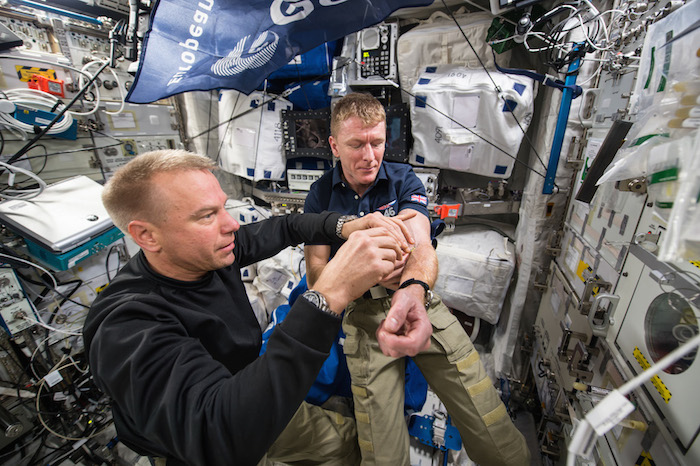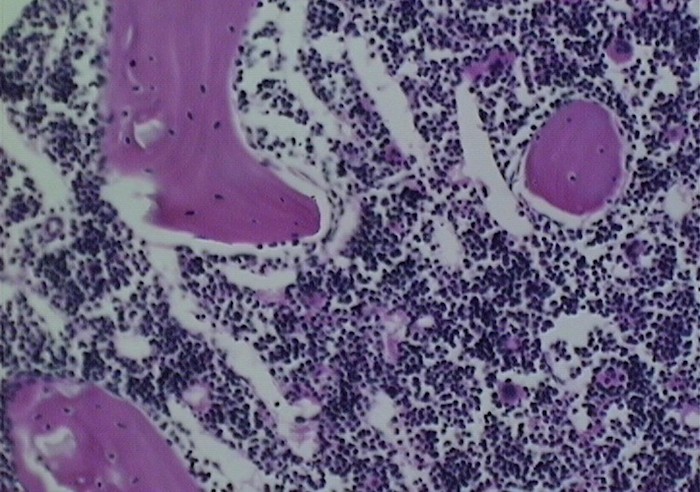.

ESA astronaut Tim Peake tweeted picture of his first blood draw completed in space. The sample was taken as part of the MARROW investigation. Credit: NASA
-
Exercise is known to boost endorphins (those “feel good” chemicals), improve mental performance, and shape physical appearance. Humans may “feel” and “see” the effects of consistent exercise but the benefits go much deeper than that. Exercise promotes the production of red and white blood cells, which boosts the immune system and enables oxygen intake. These blood cells are produced in bone marrow alongside fat cells. The production of fat cells comes at the expense of vital blood-producing cells and has been documented in astronauts returning from spaceflight.
An investigation sponsored by the Canadian Space Agency (CSA) called the Marrow study (Bone Marrow Adipose Reaction: Red Or White?) is currently taking place on the International Space Station (ISS) to determine if microgravity has a negative effect on bone marrow and blood cell production. Determining the cause for this and finding a preventative solution can benefit healthcare providers on Earth and researchers working to prepare humans for long duration missions in microgravity.
Living and working in microgravity is no easy task, and to top it off astronauts must exercise an average of two hours every day to prevent bone and muscle loss. The effects of long-duration spaceflight on astronauts range from nausea and vomiting to deterioration of the skeleton. Exercise helps to offset the unpleasant side effects that accompany the uncomfortable adjustment to living in weightlessness.
Astronauts on the ISS choose running as one of their primary sources of exercise because it improves bone, muscle, and cardiovascular health. In April 2007, NASA astronaut Sunita Williams ran the Boston Marathon (26.2 miles or 42 kilometers) while aboard the ISS during Expedition 14. She completed the first marathon in space using the Treadmill with Vibration Isolation and Stabilization System (TVIS), which had a stabilizing system that minimized the transfer of vibrations and micro-acceleration to the structure of the orbiting laboratory. Then, in 2009, the Combined Operational Load Bearing External Resistance Treadmill (COLBERT) was installed on the space station. Current ISS inhabitant and European Space Agency (ESA) astronaut Tim Peake will run the 2016 London Marathon from space on April 24.
Consistent exercise promotes the production of red and white blood cells in bone marrow. Red blood cells (erythrocytes) deliver oxygen to all the cells in the body. White blood cells fight off infection and remove abnormal cells, such as cancer, from the blood. Cells that produce fat also exist in bone marrow and accumulate throughout life and periods of prolonged bed rest on Earth.
Astronauts are exposed to increased radiation in space, so it is very important that they produce a healthy amount of white blood cells. Astronauts lacking a sufficient amount of red blood cells experience a condition known as “space anemia.” This has been documented in astronauts after returning to Earth. Space anemia poses a great risk to the mission because it can affect an astronaut’s ability to function physically and mentally in space.
“If you have fewer red blood cells, you may be more easily fatigued and have decreased strength cognitive ability, and heartfunction,” said principal investigator Dr. Guy Trudel, a professor at University of Ottawa in Canada. “Further, if inadequate red blood cell production occurs, crew members could be unable to mount an adequate response to a bleeding injury. They also would have difficulty performing duties upon returning to a gravity environment, such as landing on Mars or returning to Earth.”
Before and after spaceflight, MARROW will measure bone marrow fat using magnetic resonance imaging, or an MRI. The functions of red and white blood cells will also be analyzed before, during, and after flight. Red blood cell function will be measured by analyzing the breath of the crewmembers with a gas chromatograph. This is because the breakdown of red blood cells in indicated by the concentration of carbon monoxide in the breath. Investigators will measure white blood cell function by analyzing genetic expression. They will take a number of profiles of gene expression over time to identify the specific genes that are affected by microgravity.
.

Astronaut Sunita L. Williams, Expedition 14 flight engineer, circled Earth almost three times as she participated in the Boston Marathon from space. She is seen here with her feet off the station treadmill on which she ultimately ran about six miles per hour while flying more than five miles each second. Credit: NASA
.

Normal bone marrow.
Credits: Bone and Joint Research Laboratory, University of Ottawa.
The data gathered from this experiment will contribute more information to explain why astronauts experience space flight anemia (change in red blood cells), susceptibility to infections (change in white blood cells), and blood clots (platelets) in space. Similar conditions have been found on Earth in people with decreased mobility, confined to prolonged periods of bed rest, or with aging. A solid understanding of the relationship between fat cells and blood-producing cells in the bone marrow is crucial to minimizing the impact decreased activity has in today’s society.
.

Bone marrow showing an increase in fat after a period of immobility. Credits: Bone and Joint Research Laboratory, University of Ottawa.
.
“One important component of the investigation is looking at reversibility, whether bone marrow composition returns to preflight levels and blood cell production recovers once crews return to Earth or land on another planet,” said Trudel. “The results from this investigation could guide the search for specific countermeasures, such as exercise, or pharmacological or genetic treatments, as well as preventative interventions.”
A few years ago, NASA paid volunteers $18,000 to participate in the agency’s Bed Rest Study. To make this study an experimental analog for space flight, volunteers were exposed to a head-down tilt position that simulates the low-gravity environment in space. As part of the Flight Analog Research Unit (FARU), NASA has a special bed-rest study facility located at the University of Texas Medical Brach in Galveston, Texas. The facility is equipped with special beds that can be adjusted into various positions that manipulate the effects of different levels of gravity on the body.
Accelerated fat accumulation was found in the research that measured the fat in bone marrow during a special form of simulated microgravity bed rest. It became evident through this study that lack of physical activity causes stem cells to turn into fat rather than bone.
Fat accumulation in bone marrow and changes in blood cell function occur with normal aging, but they are also associated with conditions like paralysis, osteoporosis, and long periods of limited mobility. MARROW will provide details on how to keep blood-producing cells functioning properly in microgravity and during prolonged bed rest. The study will also help to come up with a way to reverse the negative effects of fat accumulation in bone marrow, whether it be up in space or down on Earth.
Quelle: AS
4267 Views
